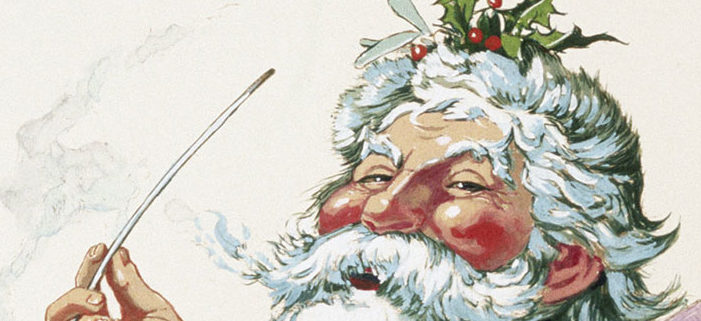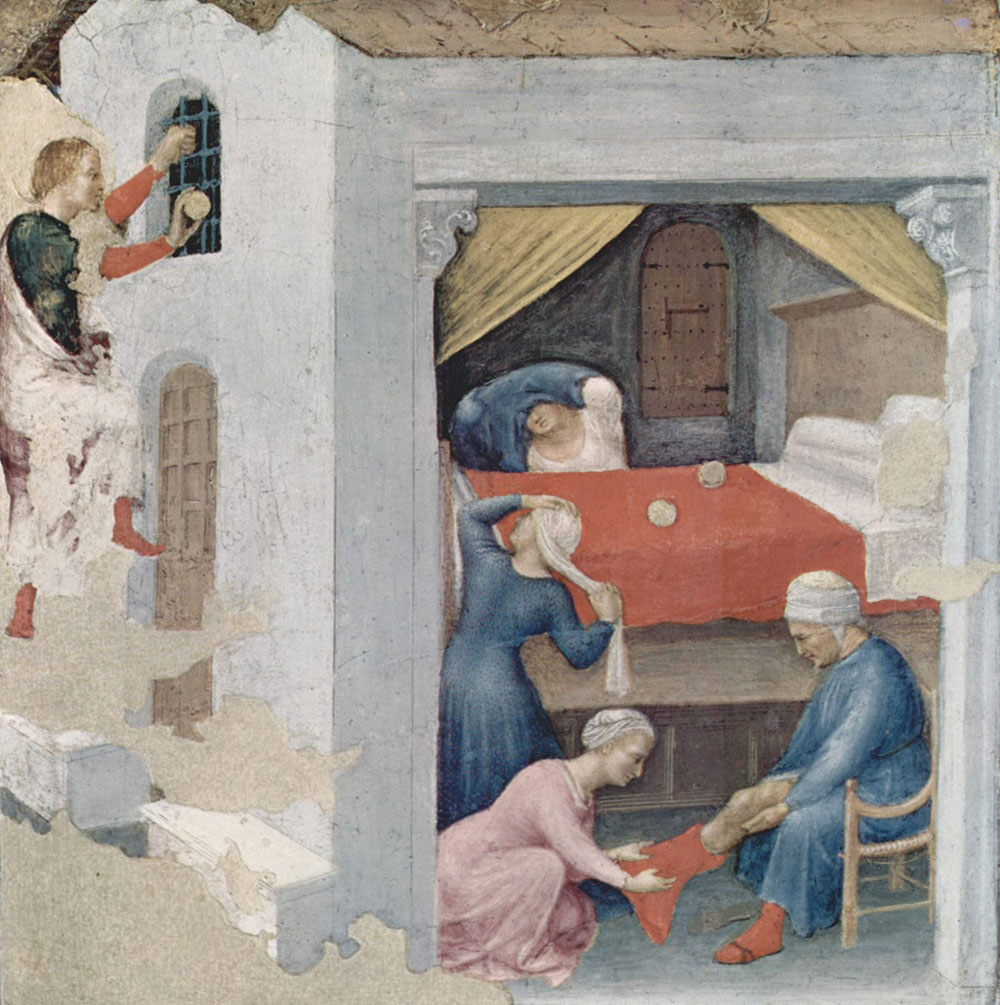嚯, 嚯, 嚯! How Santa Claus Came to China
You’d better not shout, you’d better not cry, you’d better not pout, I’m telling you why…
Chinese Fortune Grandpa is coming to town!
Wait – who?
In 2012, concerns about the encroachment of western traditions prompted a competition to design a truly Chinese gift bringer, as a rival to Santa Claus. The winner was unveiled at the Imperial Ancestral Temple in Beijing a few years back. “Chinese Fortune Grandpa” is a smiling, white-bearded man in traditional Hanfu clothing, carrying a fortune bag.
Sadly, Chinese Fortune Grandpa stood no chance against the global juggernaut of consumer Christmas, and the kindly old chap seems to have vanished without a trace. But Santa Claus’s presence in China is only the latest stage of a journey that’s already crossed continents, cultures, and centuries. We dug into the history books to find out the real story.
Santa Claus – or to give him his proper name, Saint Nicholas – was originally Asian himself, though his hometown of Myra lay at the other end of the continent, where the present-day Turkish town of Demre now stands.
Unlike many early saints, we can be fairly sure Nicholas really existed: he’s recorded as having attended the Council of Nicaea in 325CE. He’s even said to have punched another bishop, after a disagreement over theology. Curiously, a forensic examination of his remains, still preserved in Italy, established that the real Santa had a broken nose.
The reason we associate Saint Nicholas with gift-giving, and not bare-knuckle boxing, is because of an old legend in which he came secretly by night, and gave gifts of gold to a poor man who couldn’t afford dowries for his three daughters. The link with children derives from a much weirder story, about a wicked butcher who killed three children and put their bodies in a barrel, intending to make them into ham. Saint Nicholas brought the children back to life, and in church art he is often depicted with a barrel, out of which three revived kids are climbing.

Saint Nicholas was an enormously popular saint in the Middle Ages, and there were many traditions associated with him. However, we have the Dutch to thank for turning the Saint into Santa. Sinterklaas, as the Dutch call him, is depicted as an old man with a long white beard, dressed in red bishop’s robes, complete with miter and staff. He does his gift-giving rounds, not on Christmas Eve, but on his feast day of December 6, riding on a white horse instead of a sleigh.
However, Santa Claus as we know him today is a product of the cultural melting pot of the United States. The Dutch Sinterklaas mixed with the German tradition that gifts were brought on Christmas Eve, by the baby Jesus. The German word for “Christ-Child,” Christkindl, eventually mutated into Kris Kringle, and became another name for Santa.
In fact, you might say Santa is a New Yorker. The name first appeared in the New York Gazette in 1773, written as “St. A. Claus.” Later the same year Rivington’s Gazetteer reported a celebration of “the anniversary of St. Nicholas, otherwise called Santa Claus,” which involved “great joy and festivity.”
It was three NY writers who really created the modern Santa. Washington Irving, who first called the city “Gotham,” described a gift-bringing, chimney-diving Saint Nicholas in his 1809 History of New York, but this Santa rides in a wagon and dresses like a Dutch sailor. In 1821 the anonymous poem “Old Santeclaus with Much Delight” gives him a sleigh and a single reindeer, but it was the publication in 1823 of Clement Clarke Moore’s “A Visit from Saint Nicholas” which marked the true birth of the modern Santa.
So by the early 19th century, Santa Claus was already flying around on Christmas Eve in a sleigh pulled by eight reindeer (Rudolph didn’t join the crew till 1939), delivering presents down chimneys while chortling merrily. The early Santa though was often depicted as a dwarf, a “right jolly old elf.” He became the big, bearded man in red robes we know today when he merged with another legendary figure. Father Christmas appeared in England in the Middle Ages as a personification of the joys of the season, and became particularly popular when the Puritans tried to ban drinking, feasting, and merrymaking at Christmas.
There’s a widespread urban myth which claims that we think of Santa as wearing red because of an advertising campaign for Coca-Cola. It’s not true though. Coke wasn’t invented till 1886 and didn’t feature Santa in their advertising until the 1930s. Santa was first depicted in his familiar red coat lined with white fur in 1881, in a cartoon by the German-born American cartoonist Thomas Nast. Like Father Christmas, Nast’s Santa wears a holly wreath, not the tasseled hat we usually see today; Nast visited in England in 1860, shortly after the publication of Charles Dickens’s hugely popular A Christmas Carol.
And throughout this long period of evolution and cultural synthesis, how was Santa perceived in China? The truth is that before the 20th century the Chinese remained almost entirely oblivious to Christmas.
Of course, China has its own midwinter festival, dōngzhì, and its own charitable giver. Legend has it that Zhang Zhongjing, the father of Traditional Chinese Medicine, had dumpling soup made for poor people, to stop their ears from getting cold. The tradition of eating dumplings and mutton soup on the Winter Solstice continues to this day, though it is dying out under pressure from other celebrations such as Christmas.
Christianity came to China earlier than you might expect. Missionaries first arrived in the Tang Dynasty, and a stone tablet records that they were given permission to preach their faith in Xi’an in 635 CE. The so-called “Nestorian” church covered a wider area than western Christianity, stretching from the Pacific Ocean to parts of modern Turkey, and may have had more followers.

Chinese Christianity prospered under the Mongols but was virtually wiped out by the Ming Dynasty in the 14th century. The next 500 years, under both Ming and Qing, was a story of stubborn efforts by westerners to bring Christianity to China, fiercely resisted by the Emperors. Increasing colonialism in the 19th century paved the way for Christian missionaries, but it wasn’t until the 20th century that Christmas as a feast of self-indulgence began to appear.
In decadent 1920s Shanghai, the period from Christmas to New Year was the height of the party season. Andrew Field, in his fascinating book Shanghai’s Dancing World: Cabaret Culture and Urban Politics, 1919-1954, tells us that “The [Black Cat] cabaret offered a special Christmas Day celebration, with décor designed especially for the occasion, a ‘Euro-American’ (ōuměi) dancing show, and prizes given out to the guests.”
Dinner cost two yuan, and consisted of “a plate of American nuts, butter and vegetable soup, spare ribs with peas in sauce, buttery asparagus tips, beef loin, cold chicken, fried green beans, tomatoes, Washington lettuce, black pudding, salted fruits, and coffee.” Turkey is not reported as being on the menu, and while there was no doubt much going on that was both naughty and nice, Santa was not on hand to oversee the guests’ behavior.
After the establishment of the People’s Republic, both Christianity and western consumerism were very much off the menu. The closest thing to Santa was Josef Stalin, according to a poem published in the People’s Daily in 1949:
December Twenty-First,
Is the day you were born,
And for all the people of the world it is “Christmas.”
Comrade Stalin,
You deliver precious gifts to the world,
You offer wheat and warm coats to the hungry and cold,
You call the exiles home,
You give culture to the benighted,
You liberate those who have lost their freedom!
Christmas was only celebrated as an act of charity or hospitality to foreigners. In 1956, China played host to children from Poland, Hungary, Czechoslovakia, and East Germany at a party in the Beijing Children’s Palace.
“A large Christmas tree in the lobby was festooned with colored lights,” we are told. The curtains were decorated with fairytale deer, rabbits, and bears. The lights went down, and the children were treated to a private screening of the animation film Thank You Little Cat as they feasted on roasted peanuts and chestnuts.”
It was after the reforms of the 1990s that Shèngdàn lǎorén, “Christmas Old Man,” began to make serious inroads into China. As he has done elsewhere, he has quickly come to dominate but also been influenced by local culture. In Guangzhou, you might see a gang of Santas on Harley-Davidson motorbikes riding off to deliver presents to the elderly. Here in Beijing, the annual “SantaCon” brings together revelers dressed up in red and white to spread Christmas cheer (and drink copiously).
Yet he is not universally welcomed. In 2014 schools in Wenzhou, Zhejiang Province were forbidden from holding any Christmas-themed events or celebrations.
“We are not suppressing Western festivals, but we hope schools can be more balanced on this. Students can learn about Western festivals but they should not be over-enthusiastic about it,” an official told the Wenzhou Evening Post.
In the same year, Northwest University in Xi’an compelled its students to spend Christmas Eve watching a documentary about Confucius. The Beijing News reported that teachers would guard the classroom doors and “punish anyone trying to leave the room.”
Plans to build a Christmas theme park, “the Official Home of Santa,” in Chengdu seem to have come to nothing. But in many ways, China truly is Santa’s workshop. The majority of gifts which will be given in the US and Europe this Christmas are made here, and the town of Yiwu in Zhejiang Province produces 60 percent of the world’s Christmas decorations.
Perhaps most importantly, Santa Claus has serious guanxi. In 2010 he received a visit at his Lapland home from no less a person than China's current president. The then Vice-President was traveling internationally, meeting world leaders in preparation for his advancement to the top job, and was happy to be photographed sitting beside Santa in his log cabin.
With friends like that, it’s clear that poor old Chinese Fortune Grandpa never stood a chance. Shèngdàn lǎorén – Santa Claus, with Chinese characteristics – is here to stay.
READ: Beijing's Five Architectural Colors, and the Symbolism Behind Them
This article originally appeared in our sister magazine Jingkids International.
Images: bruno maestrini, Wikimedia Commons







